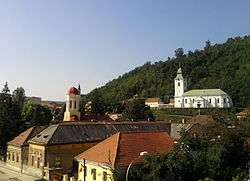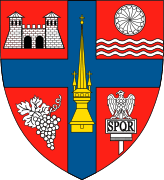Șimleu Silvaniei
| Şimleu Silvaniei Szilágysomlyó | ||
|---|---|---|
| Town | ||
|
Greek-Catholic church | ||
| ||
 Şimleu Silvaniei | ||
| Coordinates: RO 47°13′50″N 22°48′00″E / 47.23056°N 22.80000°ECoordinates: RO 47°13′50″N 22°48′00″E / 47.23056°N 22.80000°E | ||
| Country |
| |
| County | Sălaj County | |
| Status | Town | |
| Government | ||
| • Mayor | Cătălin Septimiu Ţurcaş (Democratic Party) | |
| Area | ||
| • Total | 62.26 km2 (24.04 sq mi) | |
| Population (2002) | ||
| • Total | 16,066 | |
| • Density | 260/km2 (670/sq mi) | |
| Time zone | EET (UTC+2) | |
| • Summer (DST) | EEST (UTC+3) | |
| Climate | Cfb | |
| Website | simleusilvaniei.ro | |
Şimleu Silvaniei (Romanian pronunciation: [ʃimˌle.u silˈvani.ej]; Hungarian: Szilágysomlyó, German: Schomlenmarkt) is a town in Sălaj County, Transylvania, Romania with a population of 16,066 people (2002 census). Is located near the ancient Dacian fortress Dacidava.
Three villages are administered by the town: Bic (Bükk), Cehei (Somlyócsehi) and Pusta (Csehipuszta).
History
Ancient times

Before the Roman conquest of Dacia, Şimleu was a political, social and administrative Dacian centre, of high importance.[1] Seven Dacian fortresses, some with associated settlements, were arranged in an arc shape around the hills of Şimleu.[2] They had a strategic role in the supervising the trade along the salt road coming from areas around Napoca, Potaissa and modern Dej, and heading to Pannonia.[3][4]
The centre of an early Gepidia, on the plains northwest of the Meseş Mountains, appears to have been located around Şimleu Silvaniei, where early 5th-century precious objects of Roman provenance have been unearthed.[5][6]
Middle Ages
In 1258 it was mentioned as Wathasomlyowa. The name means "Wata's mountain"; the name Wata is of Old Turkish origin, while somlyowa is an archaic Hungarian word for mountain(side).
The town belonged to the Báthory family, whose ancestral castle stood here. The castle was built by Miklós, Voivod of Transylvania in the early 13th century and was first mentioned in 1319. After the Báthory family built a mansion in the town in 1592, the castle became deserted and today lies in ruins.
The Catholic Church was built in 1534 by Transylvania's voivode Báthory István and his wife Telegdy Katalin with the occasion of their son's birth. Holy Trinity Statue was built in 1772. Reformed Church was rebuilt between 1729 and 1736. The synagogue was built in 1876.
The mansion was occupied by Giorgio Basta from Zsigmond Báthory in 1600. It was occupied by the Ottomans in 1660 and was part of Varat Eyalet until 1692. In 1703 it was occupied by Kurucs.
The Greek Catholic Vicariate of Şimleu Silvaniei was formed in 1910 and in 1817 the vicariate opened its own school. George Tatu (1810-1824), Georgiu Abraham (1824-1828), Isidor Alpini (1828-1835), Alexandru Sterca-Şuluţiu (1836-1850), Demetriu Coroianu (1850-1873), Alimpiu Barboloviciu (1873-1914), Alexandru Ghetie (1914-1922), Emil Bran (1926-1932), Petru Cupcea (1932-1940), Cornel Darabant (1940-1945), Gheorghe Ţurcaş (2004-2009) served as vicars of Şimleu Silvaniei. The old Greek Catholic church was destroyed by a storm in 1866. Notre Dame Church was built between 1871 and 1873.[7]
In 1919, Simion Barnutiu National College, the first Romanian language high school in Sălaj County was founded here, and today the town is home to three high schools.
In 1940, Şimleu Silvaniei, along with the rest of Northern Transylvania, was given to Hungary through the Second Vienna Award imposed by the Nazi Germany and Fascist Italy; Romania regained the area in 1944.
Holocaust
The Cehei ghetto operated within the town's administrative area. The ghetto was one of the Nazi-era ghettos for European Jews during World War II. It was active in the spring of 1944, following Operation Margarethe. The deportations from Cehei took place in three transports: May 31 (3,106), June 3 (3,161) and June 6 (1,584), with a total of 7,851 Jews sent to Auschwitz. Some 1,200 Sălaj Jews survived the Holocaust but later emigrated from Romania, so that by the 2000s, under fifty Jews remained in the county.
Since 1997, inside Bic Monastery, there is the wooden church from Stâna; built in 1778 it has a rectangular plan with nave and pronave.[8]
Septimiu Ţurcaş was elected in 2004 and 2008 as mayor of Şimleu Silvaniei.
Population
| Historical population | ||
|---|---|---|
| Year | Pop. | ±% |
| 1910 | 6,885 | — |
| 1930 | 7,448 | +8.2% |
| 1948 | 7,931 | +6.5% |
| 1956 | 8,560 | +7.9% |
| 1966 | 12,324 | +44.0% |
| 1977 | 14,575 | +18.3% |
| 1992 | 17,642 | +21.0% |
| 2002 | 17,053 | −3.3% |
| 2011 | 13,200 | −22.6% |
| Source: Census data | ||
According to the last census from 2011 there were 13,200 people living within the city.
Of this population, 66.77% are ethnic Romanians, while 22.87% are ethnic Hungarians, 9.82 ethnic Romani and 0.51% others.[9]
Politics
2012 election
The Şimleu Silvaniei Council, elected in the 2012 local government election, is made up of 17 councilors, with the following party composition: 7-Democratic Party, 4-Social Democratic Party, 3-Democratic Union of Hungarians in Romania, 2-National Liberal Party, and 1-People's Party – Dan Diaconescu.[10]
| Party | Seats | 2012 Şimleu Silvaniei Council | |||||||
|---|---|---|---|---|---|---|---|---|---|
| Democratic Party | 7 | ||||||||
| Social Democratic Party | 4 | ||||||||
| Democratic Union of Hungarians in Romania | 3 | ||||||||
| National Liberal Party | 2 | ||||||||
| People's Party – Dan Diaconescu | 1 | ||||||||
2008 election
The mayor Septimiu Ţurcaş was elected in the second round of 2008 local government election.
2004 election
The mayor Cătălin Septimiu Ţurcaş was elected for the first time in 2004 local government election as a member of the Democratic Liberal Party and re-elected in 2008 and 2012.
| Party | Seats | 2004 Şimleu Silvaniei Council | |||||
|---|---|---|---|---|---|---|---|
| Democratic Union of Hungarians in Romania | 5 | ||||||
| National Liberal Party | 5 | ||||||
| Democratic Party | 4 | ||||||
| Social Democratic Party | 3 | ||||||
Mayors
- József Udvari
- Octavian Guţu (b. February 23, 1946) was elected in 2000.
- Septimiu Ţurcaş (b. September 6, 1968) was elected in 2004, 2008, and 2012.
Flora and Fauna
Cehei Pond Nature Reserve is a protected area with aquatic vegetation and fauna within the town's administrative area.
Sights to see
- Cehei Pond (18,20 ha)
- Castle ruins
- Báthory mansion (16th century)
- Roman Catholic church (1532)
- Northern Transylvania Holocaust Memorial Museum
Natives
- Liviu Antal
- Andrew Cardinal Báthory
- Christopher Báthory
- Sophia Báthory
- Stefan Batory
- György Bölöni
- Elly Gross
- Joe Pasternak
International relations
Twin towns — Sister cities
Şimleu Silvaniei is twinned with:
Gallery
 Greek Catholic Church
Greek Catholic Church Reformed Church
Reformed Church Roman Catholic Church
Roman Catholic Church Orthodox Church
Orthodox Church Central park
Central park ASTRA group picture at Notre Dame Church, Șimleu Silvaniei, August 1908
ASTRA group picture at Notre Dame Church, Șimleu Silvaniei, August 1908
Notes
- ↑ Wanner 2010, p. 102.
- ↑ Wanner 2010, pp. 89-90.
- ↑ Wanner 2010, p. 79.
- ↑ Wanner 2010, p. 90.
- ↑ Bărbulescu 2005, pp. 190-191.
- ↑ Bóna 1994, p. 77.
- ↑ Scurt istoric al Vicariatului Silvaniei
- ↑ Şimleu Silvaniei
- ↑ 2002 Census
- ↑ Alegerile locale in Salaj, rezultate finale!
References
- Bărbulescu, Mihai (2005). "From the Romans until the End of the First Millenium AD". In Pop, Ioan-Aurel; Nägler, Thomas. The History of Transylvania, Vol. I. (until 1541). Romanian Cultural Institute. pp. 137–198. ISBN 973-7784-04-9.
- Bóna, István (1994). "From Dacia to Transylvania: The Period of the Great Migrations (271–895); The Hungarian–Slav Period (895–1172)". In Köpeczi, Béla; Barta, Gábor; Bóna, István; Makkai, László; Szász, Zoltán; Borus, Judit. History of Transylvania. Akadémiai Kiadó. pp. 62–177. ISBN 963-05-6703-2.
- Wanner, Robert (2010). Forts, fields and towns: Communities in Northwest Transylvania from the first century BC to the fifth century AD. Archived from the original (PDF) on 2012-01-15. Retrieved 2012-01-15.
Note
| Wikimedia Commons has media related to Șimleu Silvaniei. |
This article is based on a translation of the equivalent article from the Hungarian Wikipedia on 18 March 2007.



